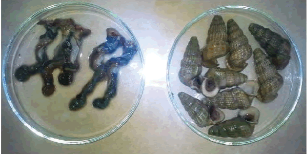
THMs constitute a major class of DBPs, including
chloroform (CHCl3), bromodichloromethane (CHCl2Br), chlorodibromomethane
(CHClBr2) and bromoform (CHBr3). Since THMs concentration in water is a serious
health concern and United States, European Union (EU) and World HealthOrganization (WHO) regulated THMs in public water supplies. Several factors in
addition to NOMs influenced the formation of THMs including the nature of
source water, amount and time of contact of chlorine, levels of total organic
compounds (TOC), temperature and pH etc.
The breaking up of double helix into single helix DNA is
called the DNA denaturation or thermal DNA melting. Theoretically, the
phenomenon has been discussed in many works, for instance the work by Hanke et
al. on the denaturation of stretched DNA. The opening double-stranded DNA canbe explained by a force exceeding a certain critical value. It is possible that
the local opening of DNA bubbles in the selective regions without breaking the
whole DNA. In other cases, the denaturation can also be influenced by many
factor such as the alkaline compound filling up a cell, liquid surrounding DNA
and other external potential. It has been shown that a bell shaped soliton
exists in the DNA chain when the effect of viscosity is taken into account.
Biochemistry is the study of structures, functions and
interactions of biomolecules, such as carbohydrates, nucleic acids, proteins,
lipids, etc. and their metabolisms. Advancements in biochemistry helps in the
advancement of different fields like agriculture, medicine, nutrition, etc.,
which are directly related to it. Combination of biochemical techniques with
techniques and ideas of genetics, molecular biology and biophysics had
facilitated the discoveries and inventions in the field of biochemistry.
Analytical chemistry is focused on the creation of new measurement techniquesand tools, experimental designs, chemometrics, etc., playing an important role
in opening new avenues in biochemistry. Recently the research in biochemistry
reached to molecular level and now the terms molecular biology and biochemistry
have become nearly interchangeable.

Journal of Biochemistry & Analytical Biochemistry is
an Open Access scholarly journal, and recently published volume 5 issue 2. In
this current issue articles in diverse disciplines of Biochemistry werepublished ranging from leaf extracts to Biomarkers, which provides a platform
for the researchers of distant related disciplines to imbibe latest
advancements that helps in their research progress.
Human activities can increase metal concentrations to
higher than background levels. The mining and processing ores, domestic waste
water effluents, storm water runoff and industrial wastes and discharges are
certain main anthropogenic sources of heavy metal pollution. Heavy metalpollution in aquatic ecosystem has been recognized as a serious environmentalproblem. In many cases, heavy metals occur in natural water bodies at levels
below their toxic thresholds, however, due to their non degradable nature, such
low concentrations may still pose risk of damage via uptake and subsequent
bioaccumulation by organisms, which cannot be effectively metabolized and these
absorbed metals are extracted.



